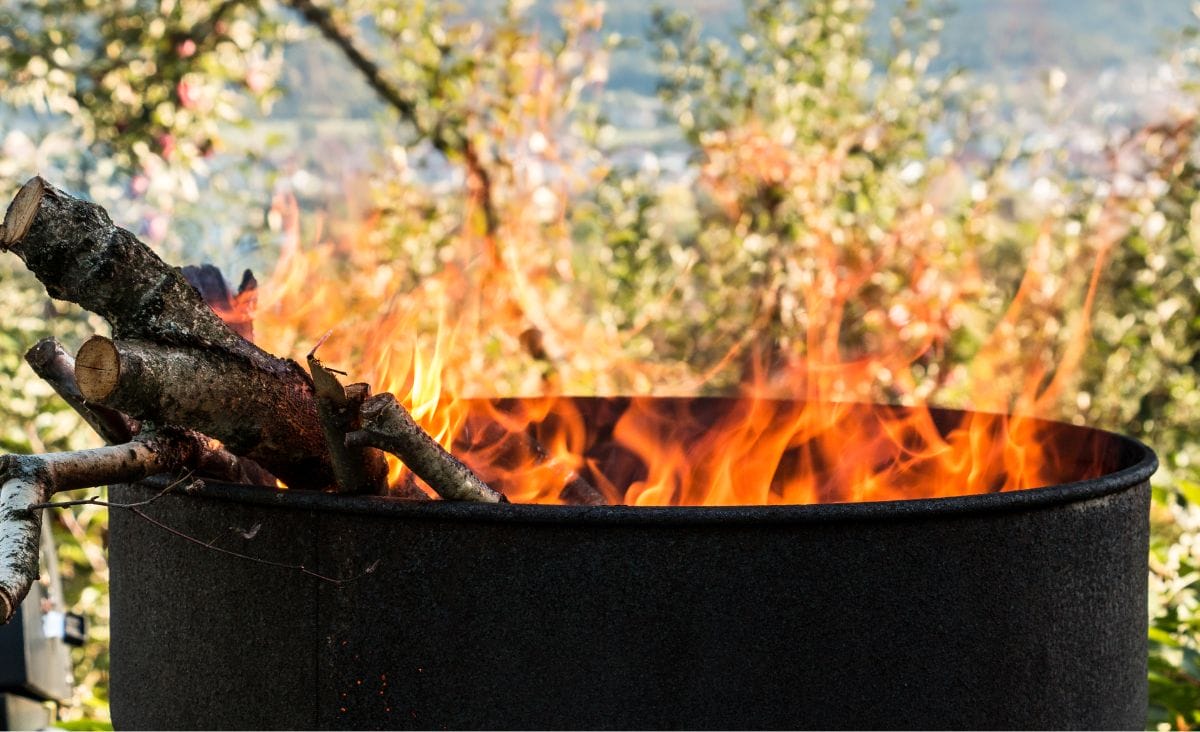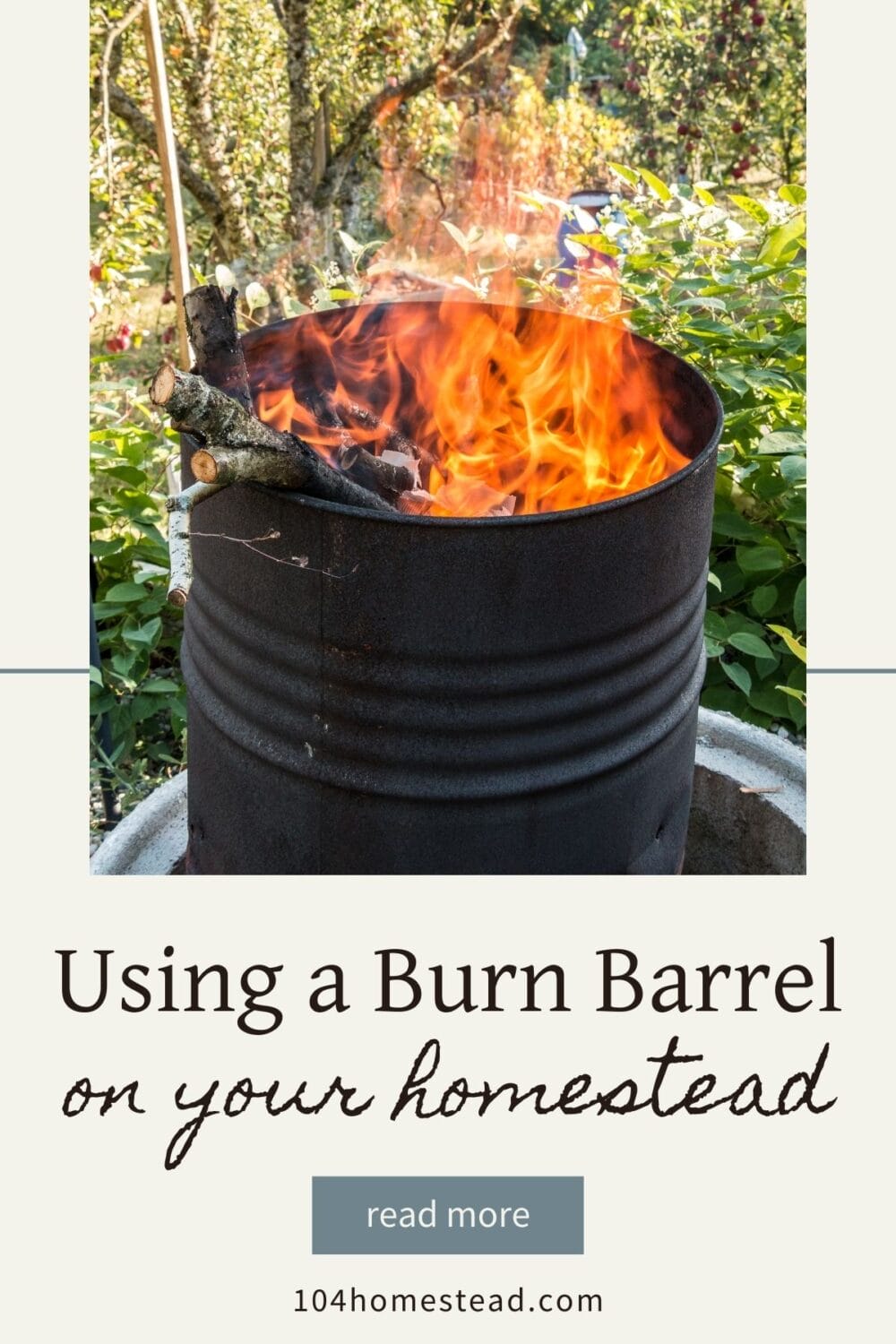Burn Barrel 101: Why You Need One on Your Homestead
Burn barrels were historically used to burn trash and household waste on farms. Learn how to make one for your homestead.

Setting up a burn barrel on our homestead has been a game changer. Some ways we use it are obvious (brush, leaves, etc), but some ways we use our burn barrel are a little less commonplace.
One thing you need to be sure to look into before setting up a burn barrel is the laws for your state and your town. In some cases, they are flat-out illegal. Some places allow you to burn leaves and brush but not trash. The best way to find out what you can legally burn in a barrel is to talk to your local fire department. They’ll also be able to help you navigate other laws that may be in place, such as hours you are allowed to burn, required water resources and tools, whether a burn permit is required, etc.
Can I buy a burn barrel at Home Depot or something?
Sure you can! Many hardware and farm supply stores sell burn barrels. A 20-gallon burn barrel runs about $40, and they go up in price as they go up in size. Amazon has a fancy-schmancy incinerator cage that can be used independently or inside a metal barrel, but dude, $500?!?! I’ll just redneck up my own, thank you very much.
How do I make my own burn barrel?
I didn’t take photos or videos when I did mine (maybe next time), but this is the same as mine. All it took was a metal drum and a drill.
Consider adding a perforated metal grate at the bottom when constructing your burn barrel. This promotes better airflow for more efficient burning and provides a stable base for your materials. The increased air circulation ensures a more complete combustion process, reducing smoke and enhancing the burn barrel’s effectiveness in managing household waste. It’s a simple addition that optimizes your burn barrel for a cleaner and more environmentally friendly homestead disposal solution.
How do I empty a burn barrel?
Well, that gets a bit tricky if you’re not exactly a “buff” person. That problem is resolved with a couple of tricks. First, empty your barrel after every burn. I struggle with this because… well… I’m lazy. If you forgot a few times or just didn’t feel inspired, you can move your barrel to the dumping location using a dolly or a tractor. I’m a tractor girl myself (any excuse to fire up the John Deere 1050).
Where should I dump out my burn barrel?
This is one of those times I don’t condone composting. Ash is, in moderation, great for the garden, but unless you’re burning straight wood in your burn barrel… maybe not this time. I dump mine in a low area on my property. It’s out of the way, so people won’t step in it and track it through the house, and it’s slowly leveling up the area. An out-of-the-way corner of your yard would work as well. If you’re concerned about the contents in your barrel ash, you can bag it in a heavy-duty trash bag and take it to the transfer station to dispose of it.
Things you can burn in a barrel (assuming it’s legal in your area):
No. Seriously. Check the legalities before you light a match. I don’t want you all coming back here saying, “I did this and this, and now I’m spending the 4th of July in the pokey.” I tried to warn you.
Landscaping
- Dried lawn clippings
- Tree branches
- Dead leaves
Trash
- Non-recyclable paper products and cardboard
- Food wrappers
- Old, ruined, or unwanted clothing from your farm family (natural fabrics only)
Farm Life Stuff
- Bailing twine (because, let’s be honest, you can only repurpose so much of it)
- Empty feed sacks (paper ones)
We disposed of logging debris after a day of harvesting free firewood.
Please, please don’t burn this stuff:
Some stuff should NOT be burned in a barrel because it’s not safe for the environment and/or your health. These things include…
- Food Scraps – Compost them instead!
- Plastic Recyclables – At least give them a chance to be recycled, or (like in the case of food containers) reuse them on your homestead.
- Lightbulbs, Batteries, Aerosol Cans – Avoid anything that can go boom.
- Hazardous Materials – This includes paints, cleaners, and any other chemicals you might have lying around.
- Electronics – I mean, why would you bother?
- Coated, Painted, or Pressure Treated Wood – I’m just going to say this is a “do as I say and not as I do” situation.
- Combustible Materials – Duh!
- Tires or Rubber Products (no… just no)
People often ask if they should use accelerants like kerosene or gasoline when starting their barrels. While legally obligated to say, “Oh hell no,” some people do and some don’t. I choose not to. I have some really dry pine stacked near my barrel, and I’ll use that to get things going. A propane torch helps with the process as well. Avoid burning on windy days or when the ground is dry. You can protect the ground from burning by putting your burn barrel up on concrete blocks. A sheet metal lid makes a great rain cover when your barrel isn’t in use.
Frequently Asked Questions
If you’ve found value in this blog post and enjoyed reading it, why not share it with your Pinterest community? Pin the image below and spread the love!

And there you have it—your ticket to homestead-burning bliss! Whether you’re diving into the world of burn barrels for the first time or giving your seasoned barrel a high-five, remember, it’s not just about flames; it’s about creating warmth from waste.
Chat with me in the comments about your burn barrel tales, from the unexpected joys to the ingenious tricks. Let’s keep the homestead spirit alive and burning!

I would like to add, do not burn when there is a burn ban on. Fires can spread quickly, when it’s too dry. If you are disposing your ashes, be certain that the barrels have been extinguished and sitting for two or more days.